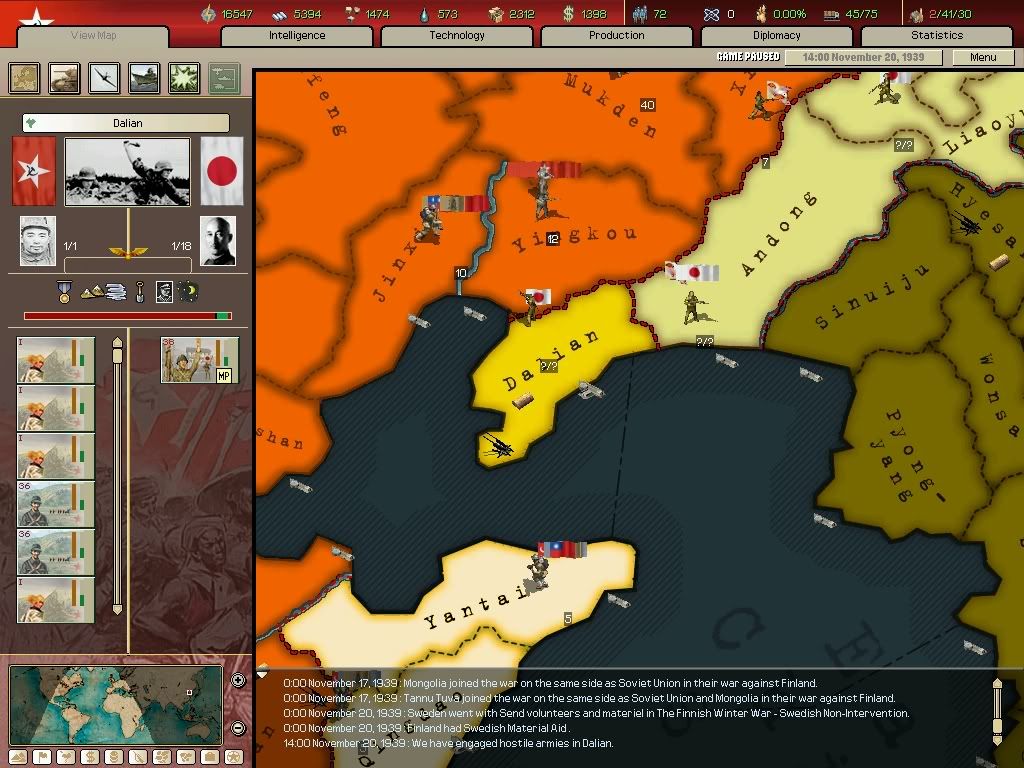Gack! Things are looking bad for those besieged troops in Beiping. I am guessing the navy thing is still a ways off?  Like how you tied the loss of the tech team into the loss of Jinan, that was clever...and must have been very frustrating being that close to completion.
Like how you tied the loss of the tech team into the loss of Jinan, that was clever...and must have been very frustrating being that close to completion.
China Rules the Seas
- Thread starter Rodrico Stak
- Start date
-
We have updated our Community Code of Conduct. Please read through the new rules for the forum that are an integral part of Paradox Interactive’s User Agreement.
You are using an out of date browser. It may not display this or other websites correctly.
You should upgrade or use an alternative browser.
You should upgrade or use an alternative browser.
China Rules the Seas
A Chinese Naval AAR
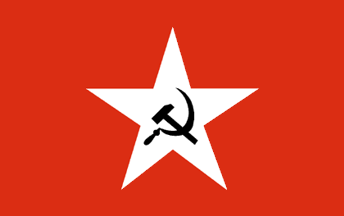
Operation Fading Sun: Part 3
A Chinese Naval AAR

Operation Fading Sun: Part 3
After the isolation of Beiping on December 7, Red Army high command dictated that the relief of Beiping was to be of top priority. For the next 5 days, the fate of Beiping hung in the balance.
Finally, on December 12, mountaineers of the 1. Red Army Div under Maj. Gen Ye Ting reopened supply lines to Beiping through the recaptured province of Baoding. Maj. Gen Ye Ting was to go down in history as the first man to earn the Medal of the Army.
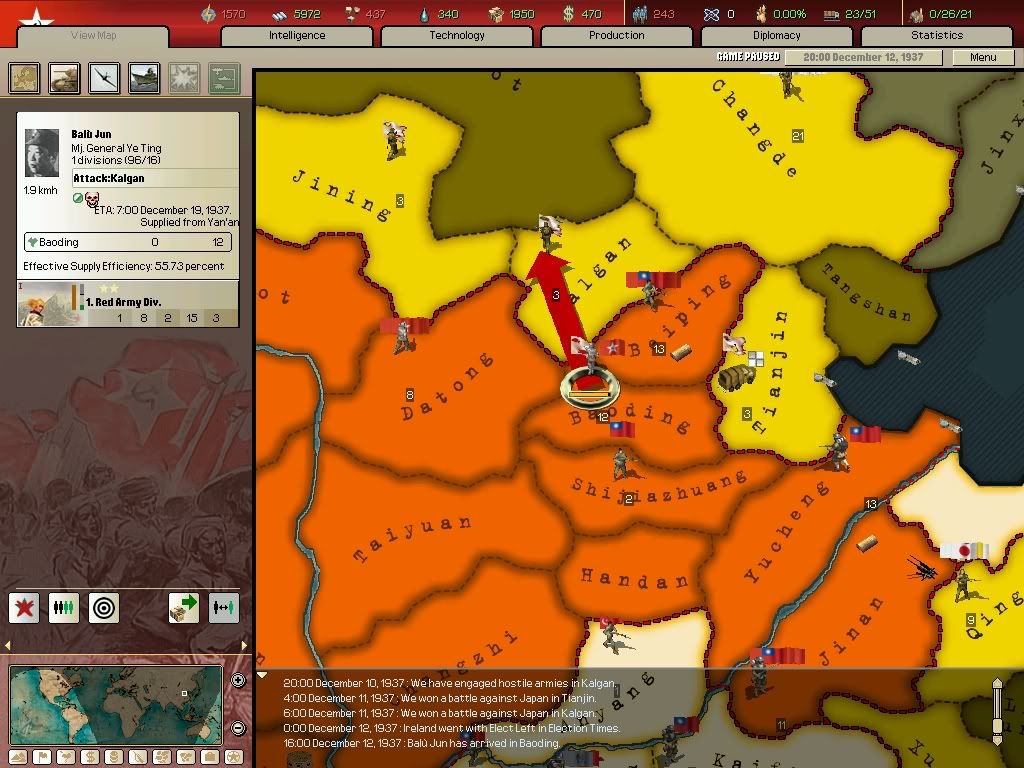
This action stabilized the Northern Front, and new offensive maneuvers began on the Southern Front, as attacks were organized on Qingdao. Though the first of these attacks (begun December 26, 1937) was repelled, the second, on January 3, 1938 succeeded, and Kuomintang troops entered the town of Qingdao on January 25.
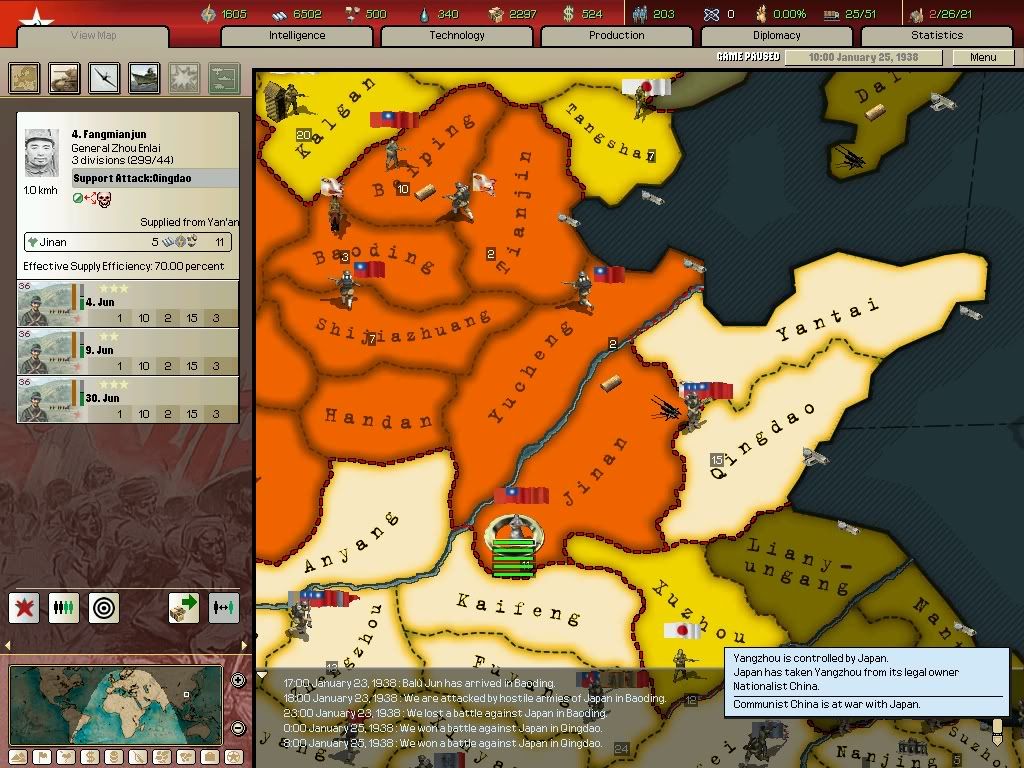
Next, an attack was organized on Chengde. Though it was repelled by the Japanese defenders, Field Marshal Mao Zedong did develop new tactics for fighting in the hills based upon his experiences in Chengde.
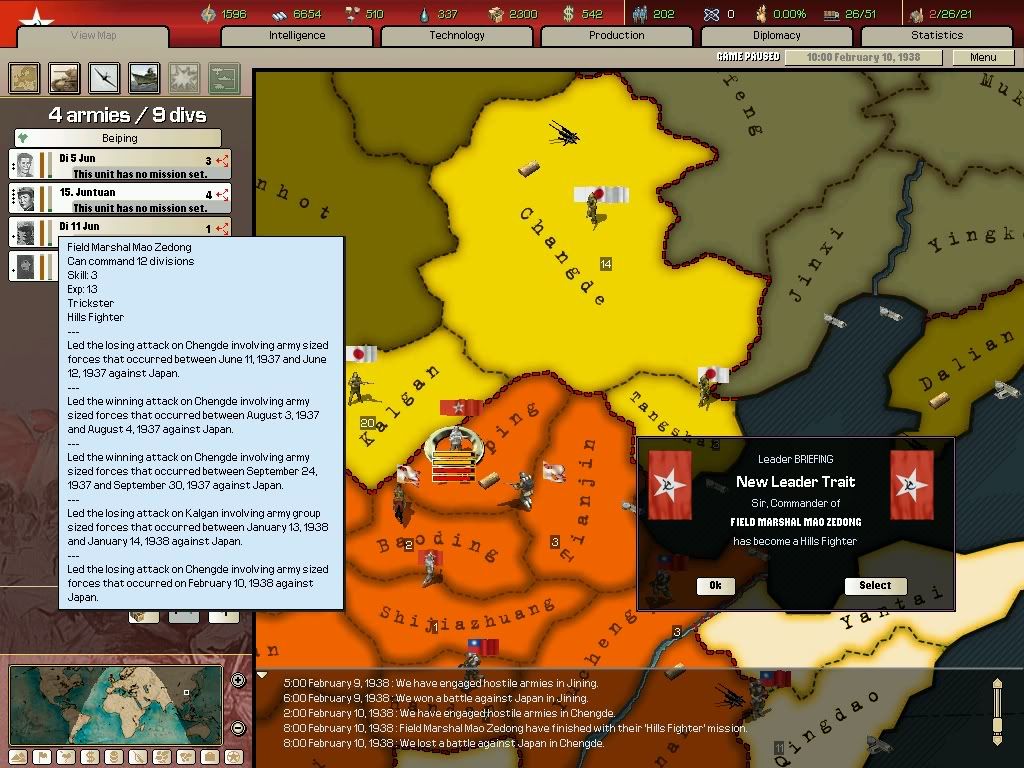
Meanwhile, Japanese forces exploited a weakness in the defense of Baoding, and took the province. Unwilling to allow Beiping to be encircled a second time, the Red Army organized a counterattack was organized on the province, throwing the Japanese back.
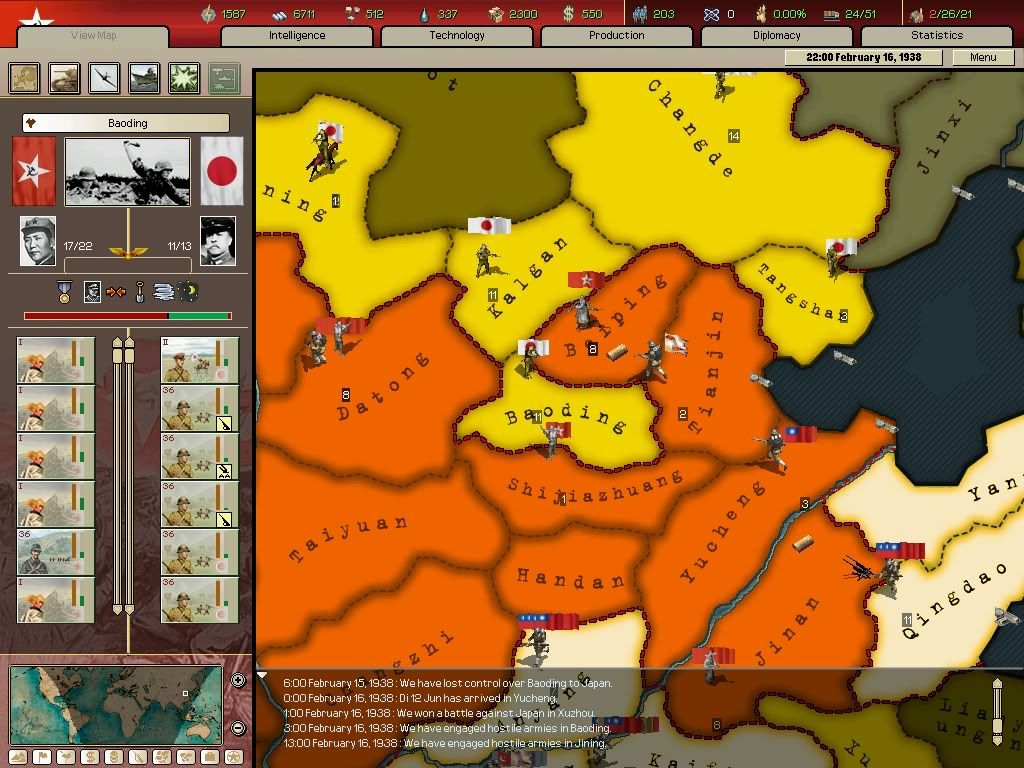
An attack was then made on Kalgan, in the hopes of overrunning the Japanese divisions retreating from Baoding.
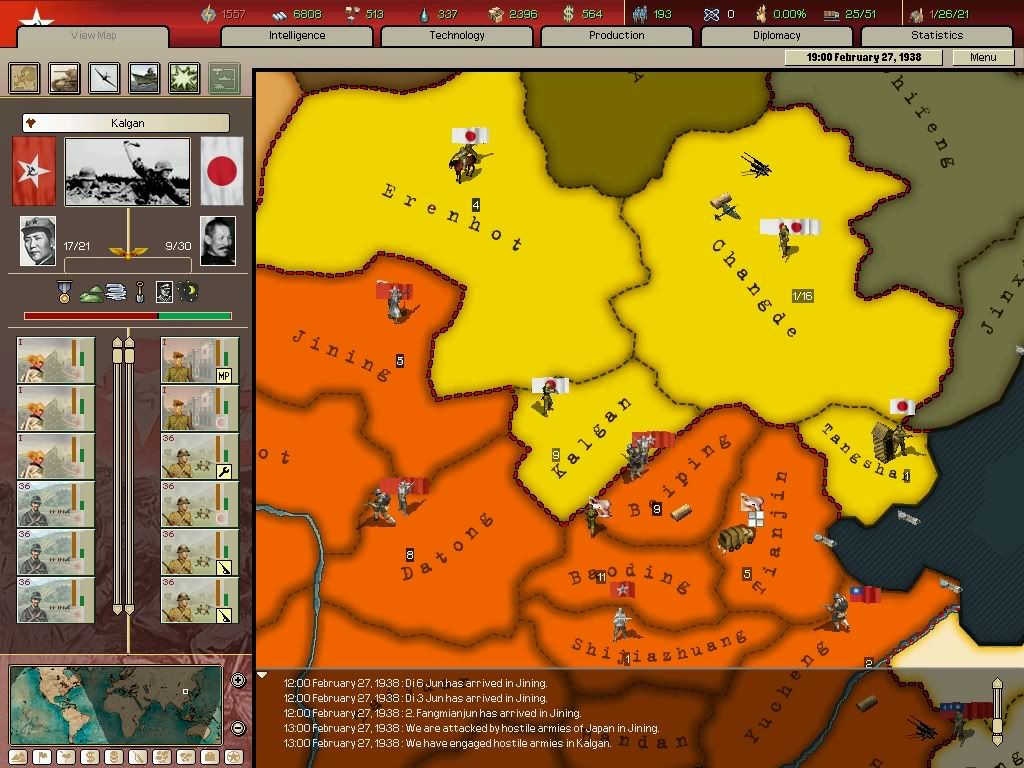
The divisions retreating from Baoding made it to Kalgan first, however, and while they were defeated and the province was taken, the attack failed to fulfill its original purpose. Meanwhile, Japanese forces took the useless province of Jining, and a successful counterattack was made.
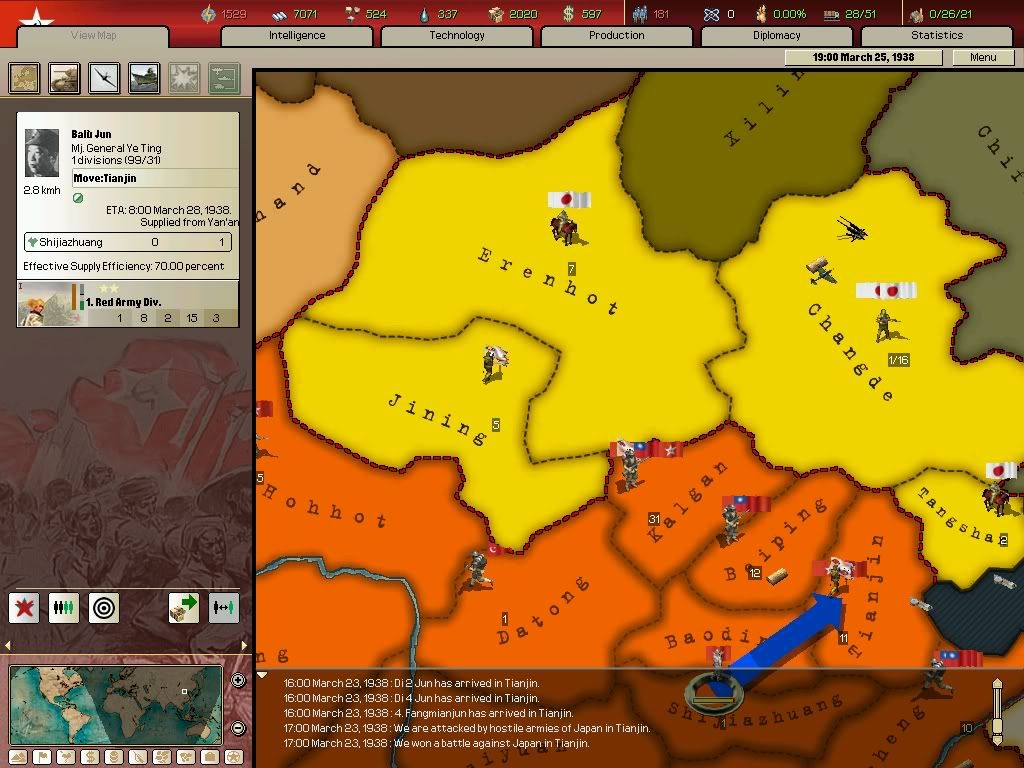
Next, forces in Tianjin attacked Tangshan. The capture of Tangshan was to mark a turning point in the Sino-Japanese war in the favor of the Chinese, both Communist and Nationalist alike, by allowing them to go on the offensive for the first time in what had essentially been a defensive war.
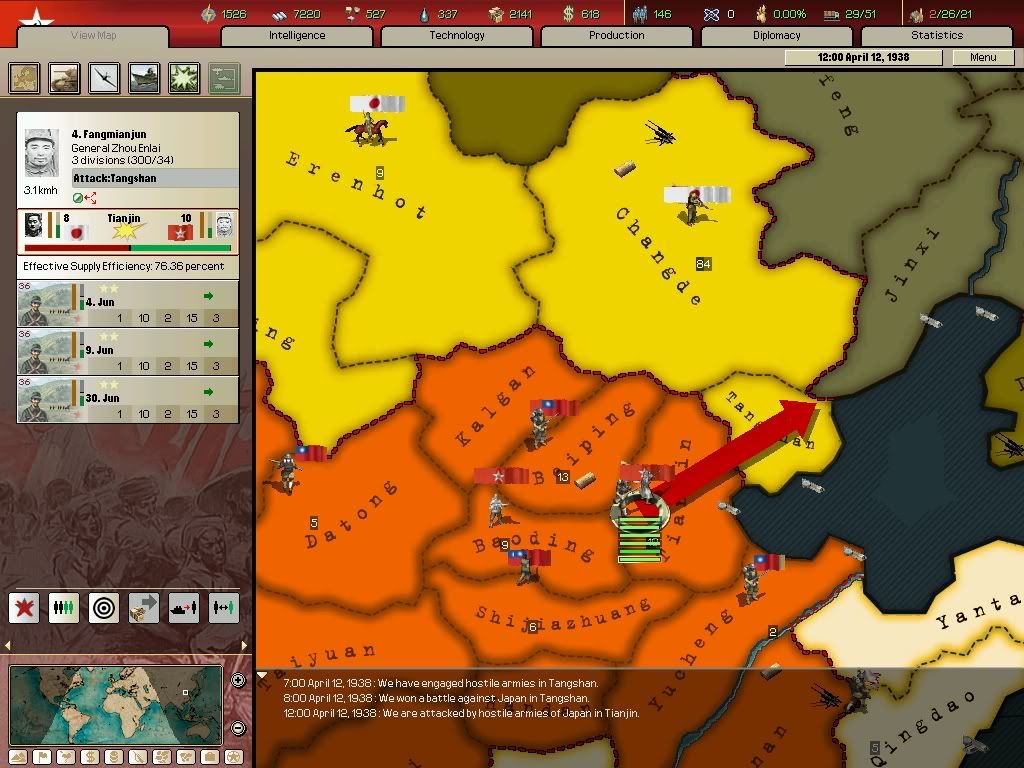
one suggestion
if you have claims on mongolia have claims on entire korea&laos/vietnam
remember those where imperial chinas territories!
if you have claims on mongolia have claims on entire korea&laos/vietnam
remember those where imperial chinas territories!
It is, as you will see.4th Dimension said:I do hope this is a turning point.
Well... it is tempting, but Indochina (Laos, Vietnam, Cambodia) already has 0 partisan activity as its base... and I don't think that the modern population of Indochina would be too happy if they got annexed into China. I intend to set up a Korean puppet state, and this is entirely historical with regards to Imperial China, as for much of its history Korea was more like a vassal of China, or at least to my understanding. Still, the same argument as with Indochina remains.Deus Eversor said:one suggestion
if you have claims on mongolia have claims on entire korea&laos/vietnam
remember those where imperial chinas territories!
China Rules the Seas
A Chinese Naval AAR

Operation Fading Sun: Part 4
A Chinese Naval AAR

Operation Fading Sun: Part 4
On May 11, Deng Xiaoping succeeded in implementing his new form of Improved Machine Tools, and immediately began work on advancing their design:
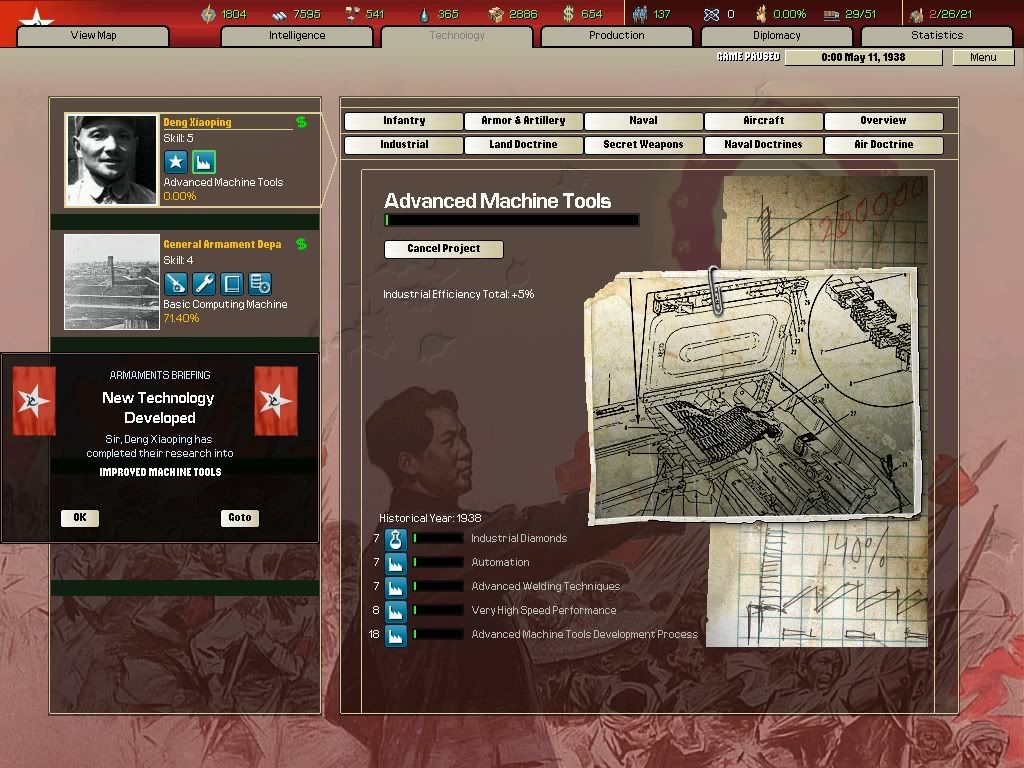
Meanwhile, the Red Army advanced further into Japanese territory, taking Chengde and Erenhot and even advancing into the Manchukuoan province of Jinxi.
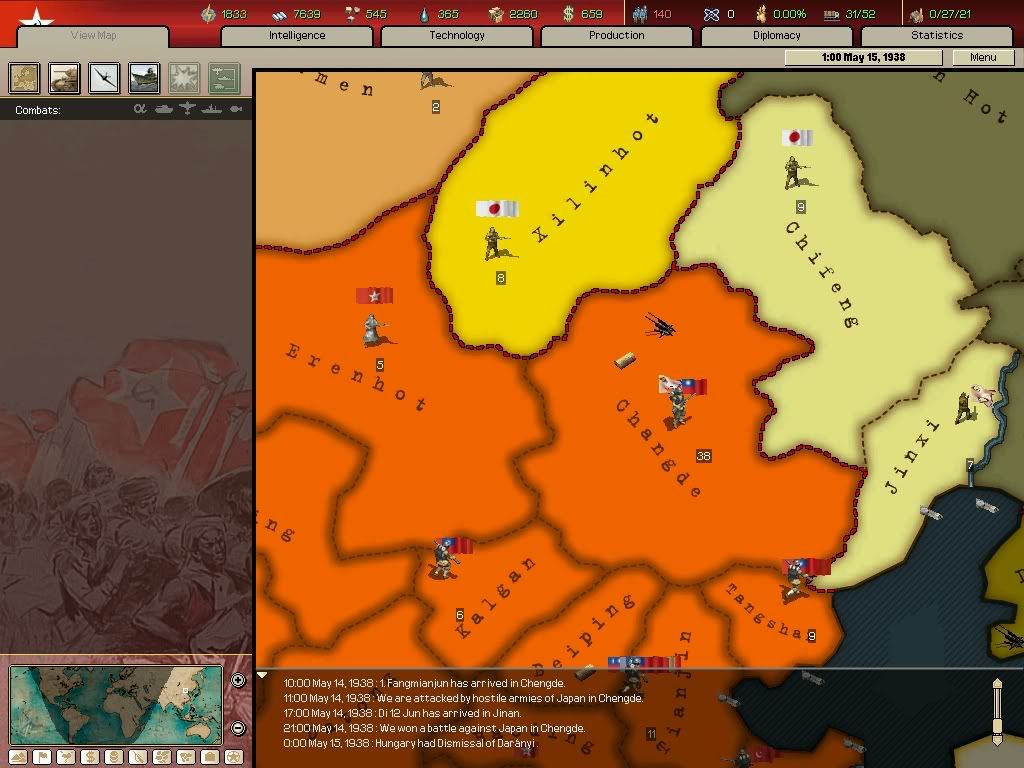
On the Southern Front, Kuomintang forces managed to surround and force to surrender some Japanese divisions in Kaifeng.
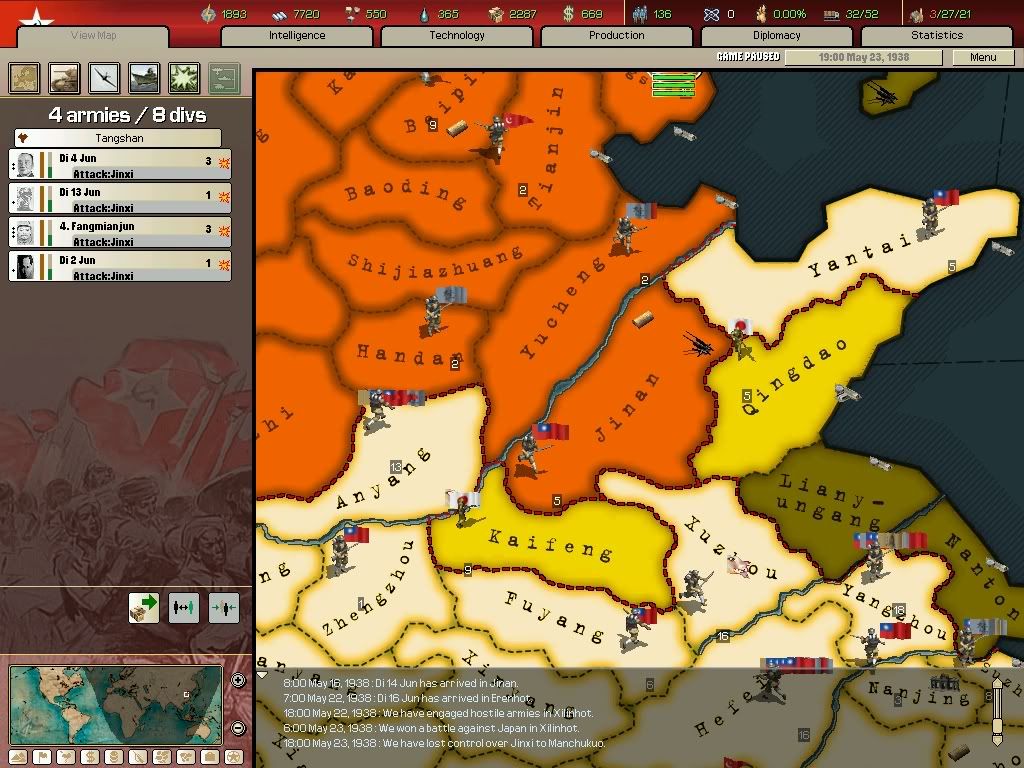
On the Northern Front, the Red Army and the Imperial Japanese Army battled over control of the relatively useless province of Xilinhot, though neither side could achieve a lasting victory, and the province switched hands several times before finally being taken by Kuomintang forces in early July. During this time, attacks were made on the strategically important province of Mukden, in the industrial heartland of Manchukuo.
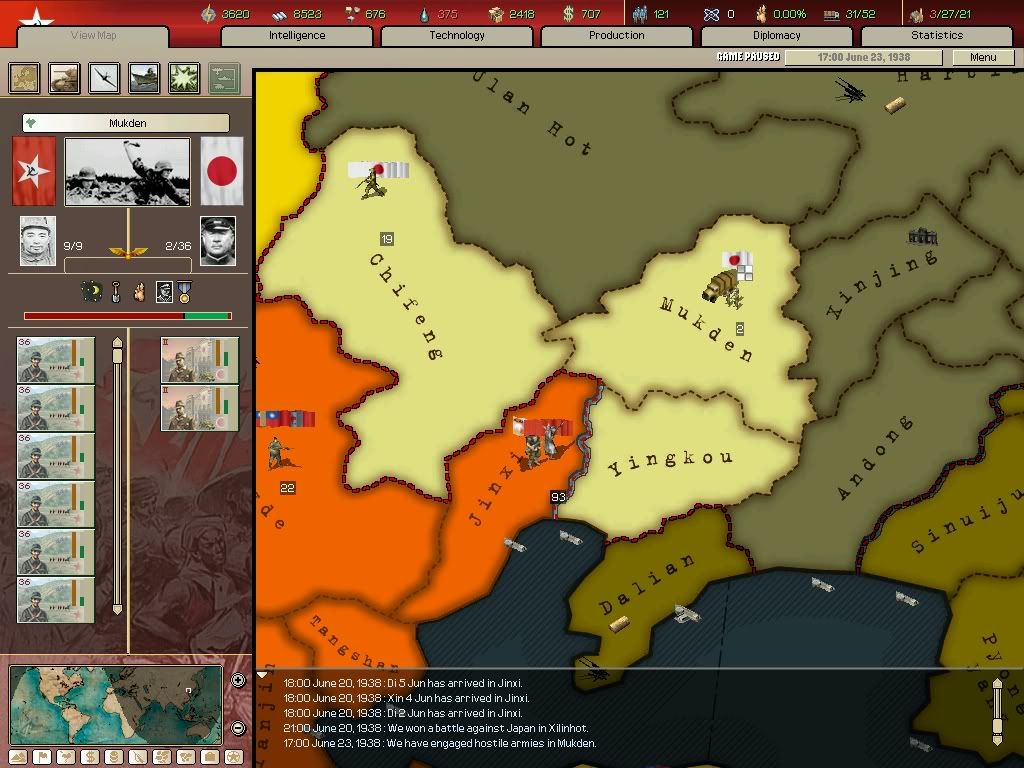
Though the Japanese forced back the attacking force after it occupied Mukden, it was a significant, though temporary, blow to the industrial capacity of Manchukuo.
The Red Army then opened an attack on the province of Chifeng, with support from the Nationalist Revolutionary Army. It was estimated that the province would be secured in about one month.

On the Southern Front, things did not look as good. Though part of the Japanese force had been destroyed in Kaifeng, the Japanese still fielded a large enough force to take Jinian on August 11, destroying the General Armament Department's experimental Basic Computing Machine.
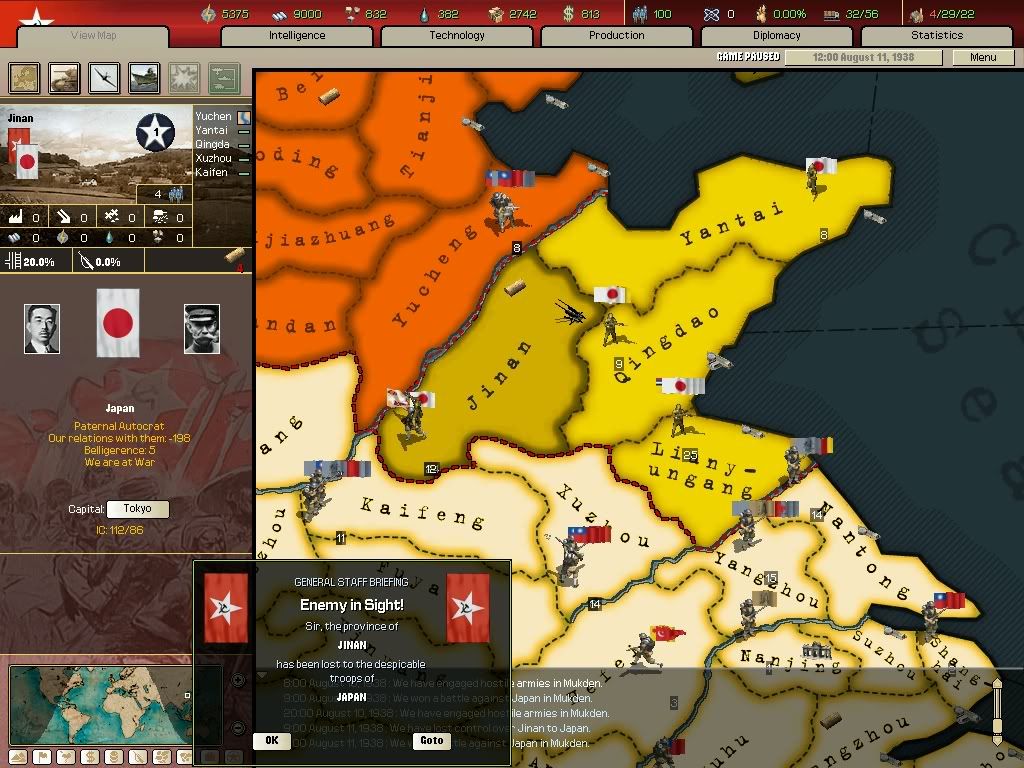
However, Kuomintang forces quickly forced the Japanese out of Jinian.
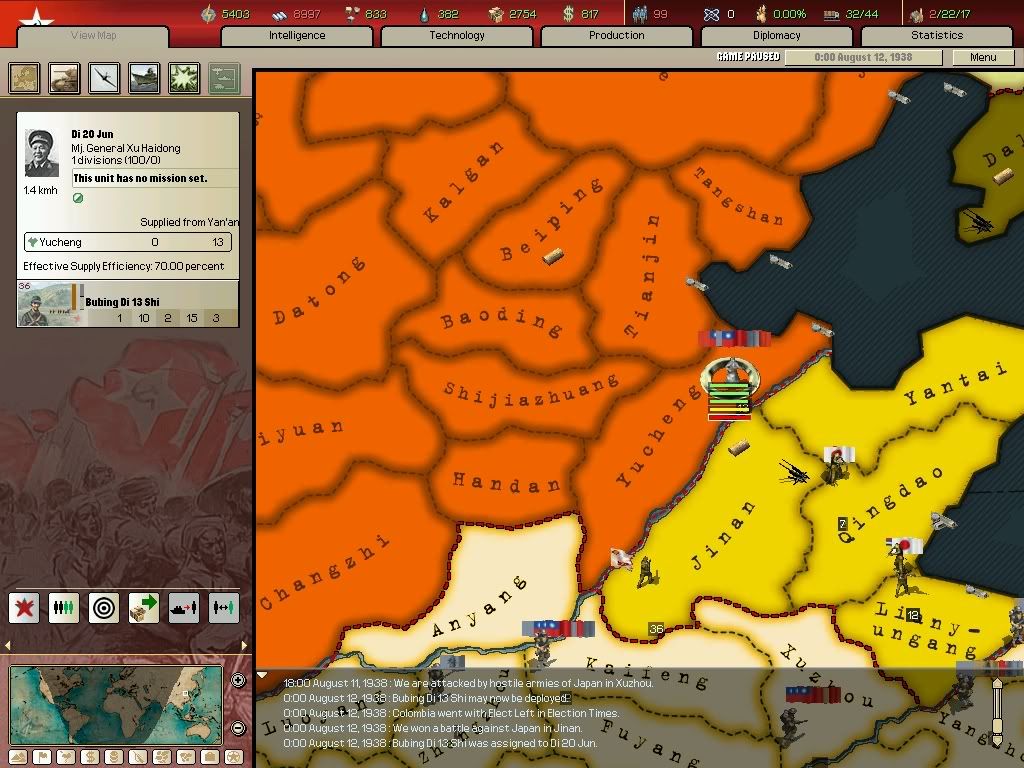
One day after the Japanese began retreating from Jinian, Chifeng was taken, making it the second Manchurian province to fall into Communist hands. It would not be the last.
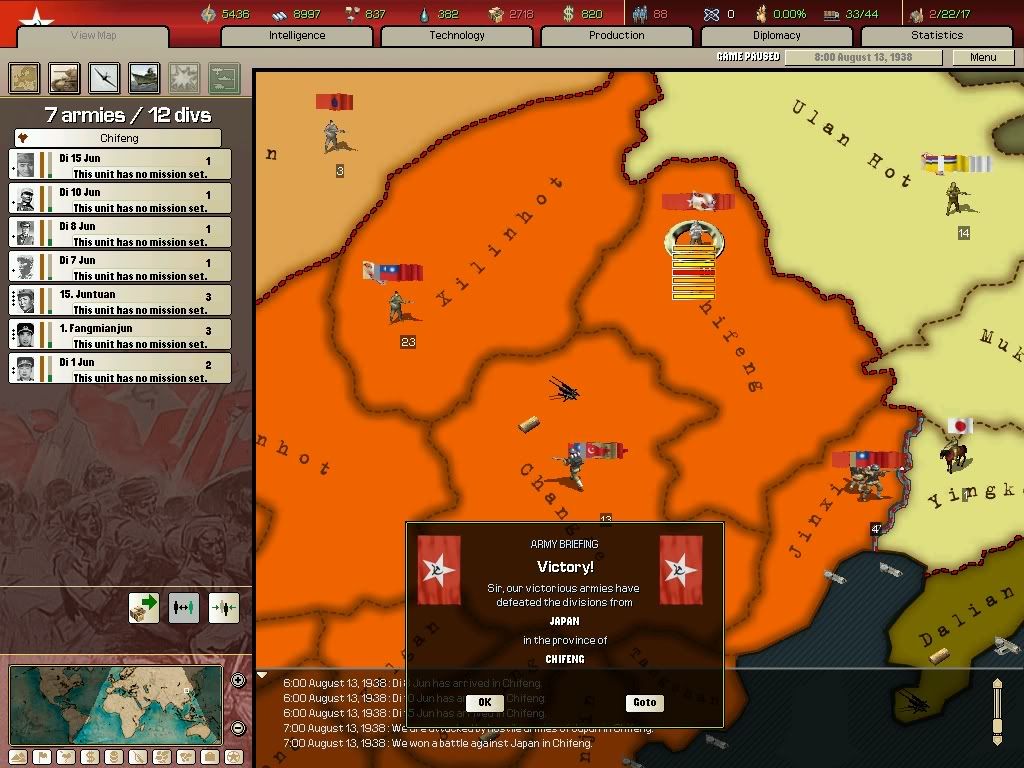
Well, my game is so far ahead of this AAR that I must present the longest update to er... date. (please pardon the pun)
On September 5, enough industry became available that General Armament Department could be contracted to develop modern methods of agriculture, as the agricultural processes in Communist territory had not evolved since the days of the Qing Empire.
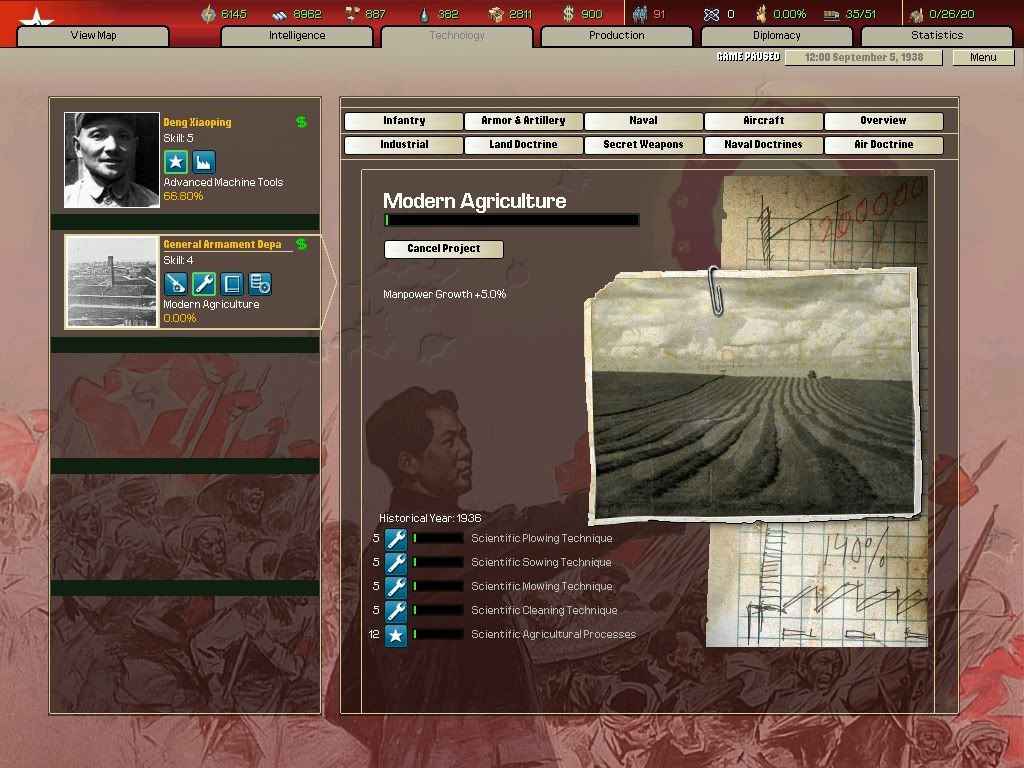
On the Southern Front, the Red Army attacked Yantai, hoping to push back the 2 Japanese divisions stationed there. The attack was a resounding success.
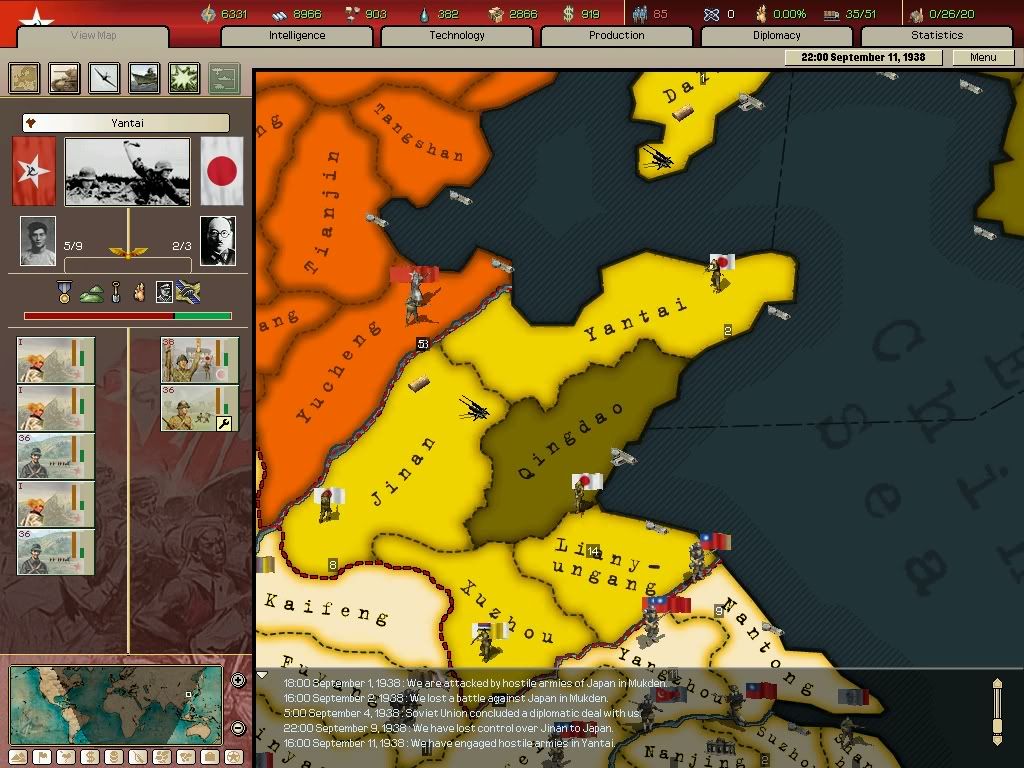
On the Northern Front, a furious back-and-forth battle raged over the province of Mukden, with neither side able to secure the vital factories contained there. However, Chinese forces were able to take and hold the provinces of Dalian and Andong, creating a border with Japanese-occupied Korea.

The Japanese were even so desperate to hold Mukden that they attempted Banzai charges.
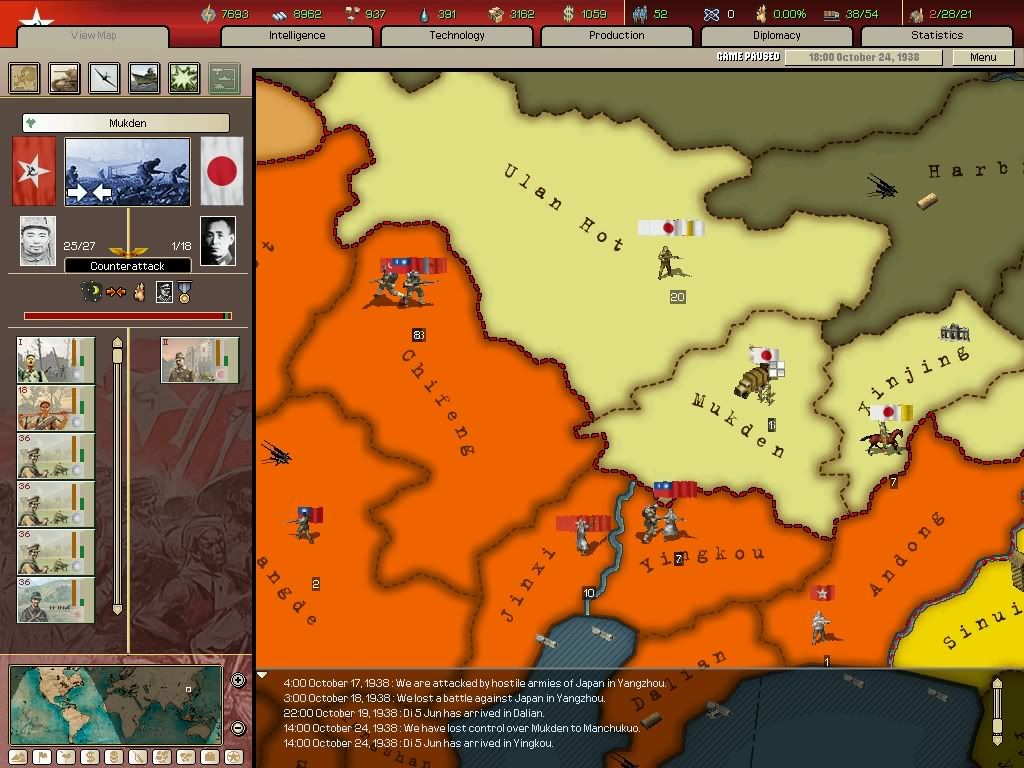
In the South, things looked bad for the Japanese, as they began to be overwhelmed by the sheer numbers of Kuomintang and warlord troops.
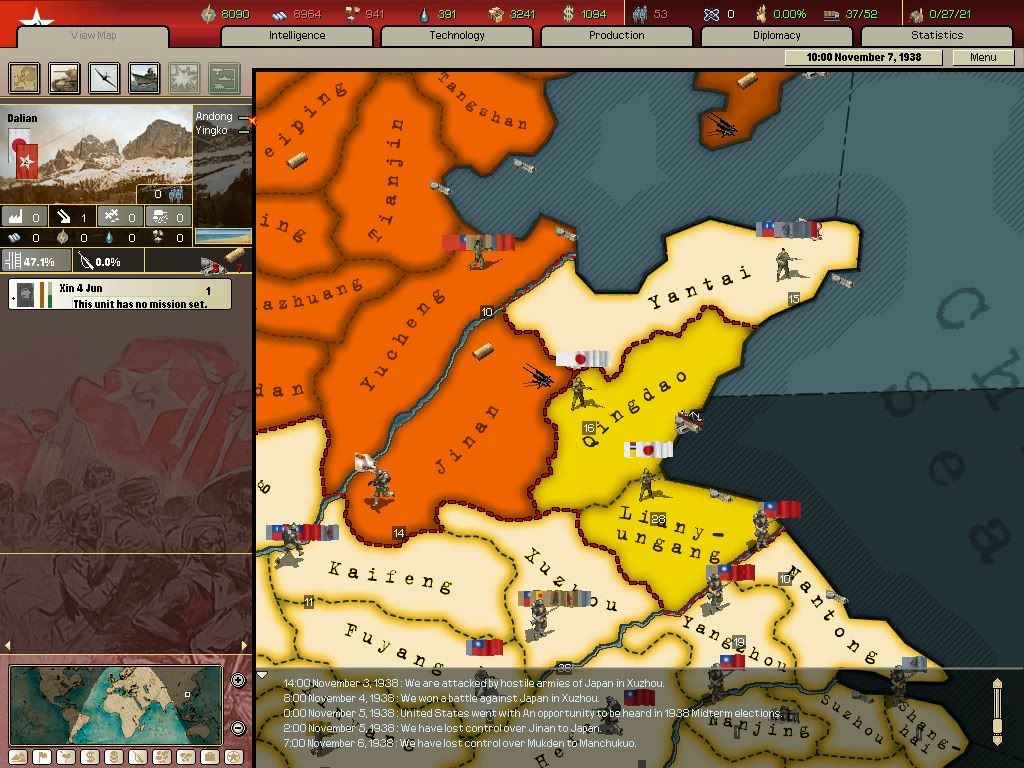
On November 27, Deng Xiaoping developed Advanced Machine Tools, helping to maximize the industrial output of the Communist's factories. The School of Oriental Munich was then contracted to improve the equipment of the Red Army's mountaineers.
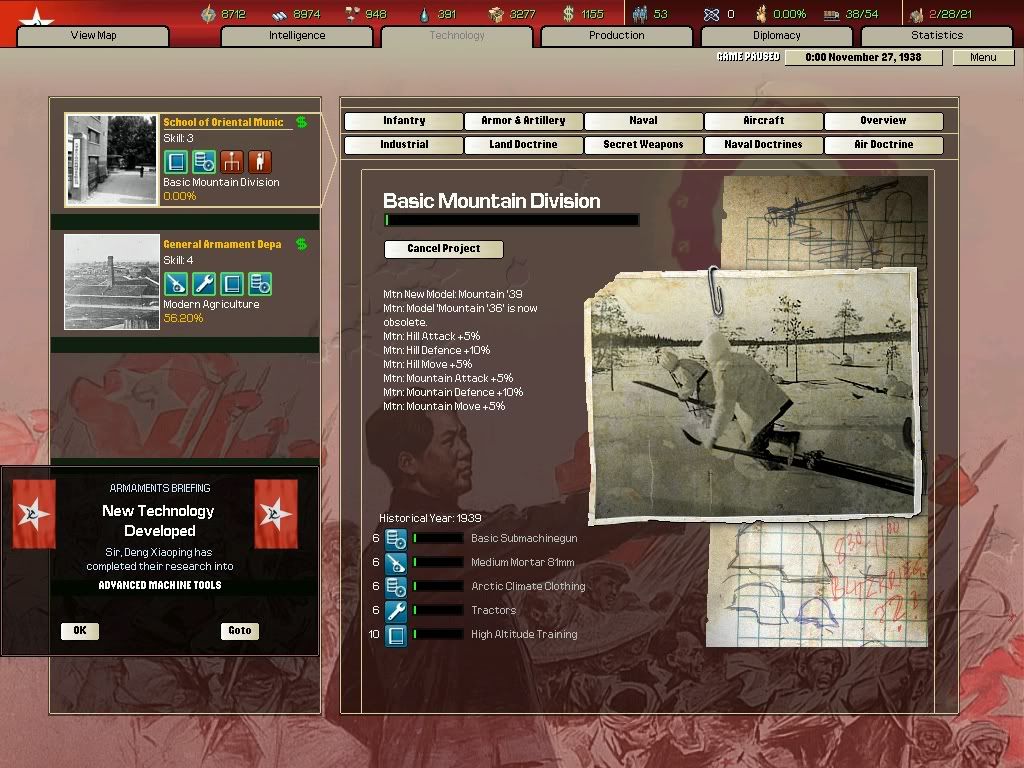
The first attack by the Red Army onto non-Chinese soil took place on December 6, as an attack into Korea occurred.
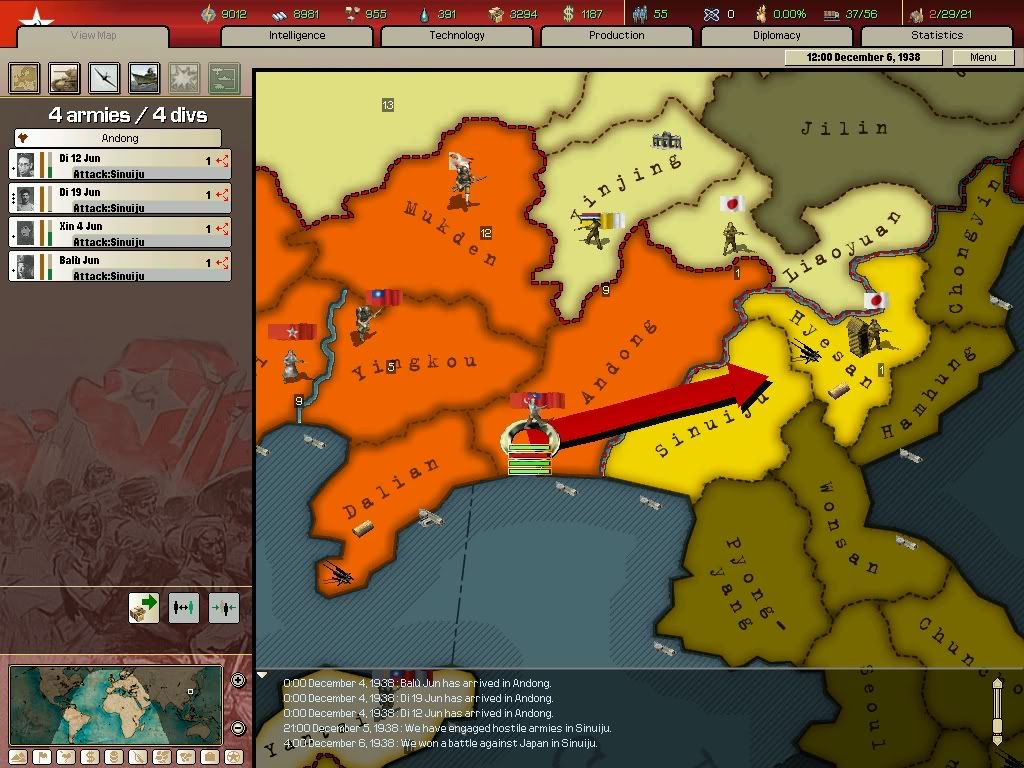
On December 12, new breakthroughs in agricultural science greatly boosted the number of men available for conscription into the army across all of China (or, it was at this point that I realized that I forgot to use the vanilla manpower for China instead of CCIP's reduced manpower, and fixed the problem).
The Northern Front then remained stable (except for the almost never-ending battle over Mukden), for the rest of the winter, as neither side could hope to advance in such frozen conditions. Further South, however, the Japanese made some minor gains, though this only overextended them, leading to Japanese divisions being surrounded and forced to surrender.
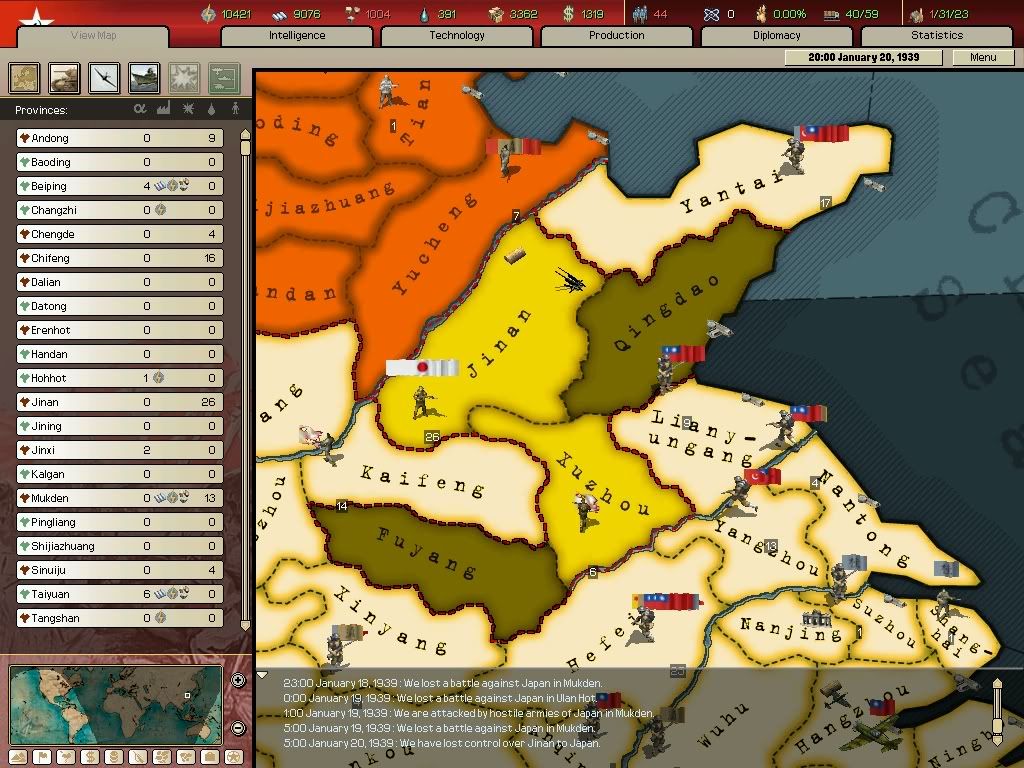
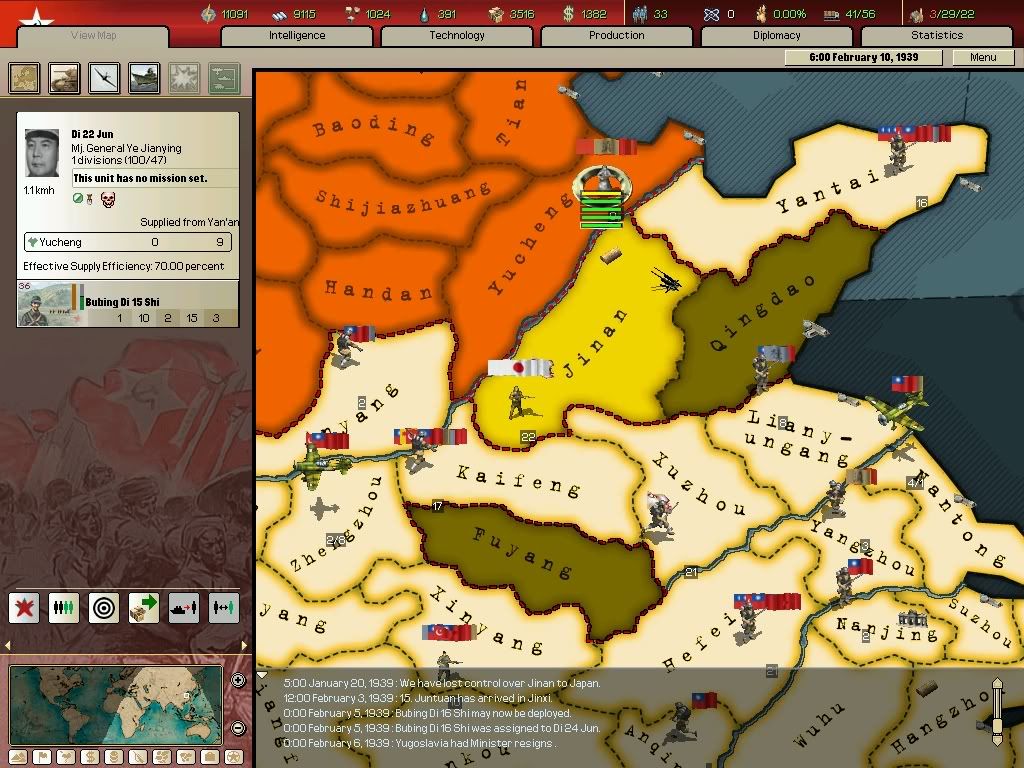
China Rules the Seas
A Chinese Naval AAR

Operation Fading Sun: Part 5
A Chinese Naval AAR

Operation Fading Sun: Part 5
On September 5, enough industry became available that General Armament Department could be contracted to develop modern methods of agriculture, as the agricultural processes in Communist territory had not evolved since the days of the Qing Empire.

On the Southern Front, the Red Army attacked Yantai, hoping to push back the 2 Japanese divisions stationed there. The attack was a resounding success.

On the Northern Front, a furious back-and-forth battle raged over the province of Mukden, with neither side able to secure the vital factories contained there. However, Chinese forces were able to take and hold the provinces of Dalian and Andong, creating a border with Japanese-occupied Korea.

The Japanese were even so desperate to hold Mukden that they attempted Banzai charges.

In the South, things looked bad for the Japanese, as they began to be overwhelmed by the sheer numbers of Kuomintang and warlord troops.

On November 27, Deng Xiaoping developed Advanced Machine Tools, helping to maximize the industrial output of the Communist's factories. The School of Oriental Munich was then contracted to improve the equipment of the Red Army's mountaineers.

The first attack by the Red Army onto non-Chinese soil took place on December 6, as an attack into Korea occurred.

On December 12, new breakthroughs in agricultural science greatly boosted the number of men available for conscription into the army across all of China (or, it was at this point that I realized that I forgot to use the vanilla manpower for China instead of CCIP's reduced manpower, and fixed the problem).
The Northern Front then remained stable (except for the almost never-ending battle over Mukden), for the rest of the winter, as neither side could hope to advance in such frozen conditions. Further South, however, the Japanese made some minor gains, though this only overextended them, leading to Japanese divisions being surrounded and forced to surrender.


(continued from Operation Fading Sun: Part 5)
On March 23, 1939 an attack was made on Ulan Hot, the Japanese garrison of which had been greatly reduced by the never-ending battle of Mukden.
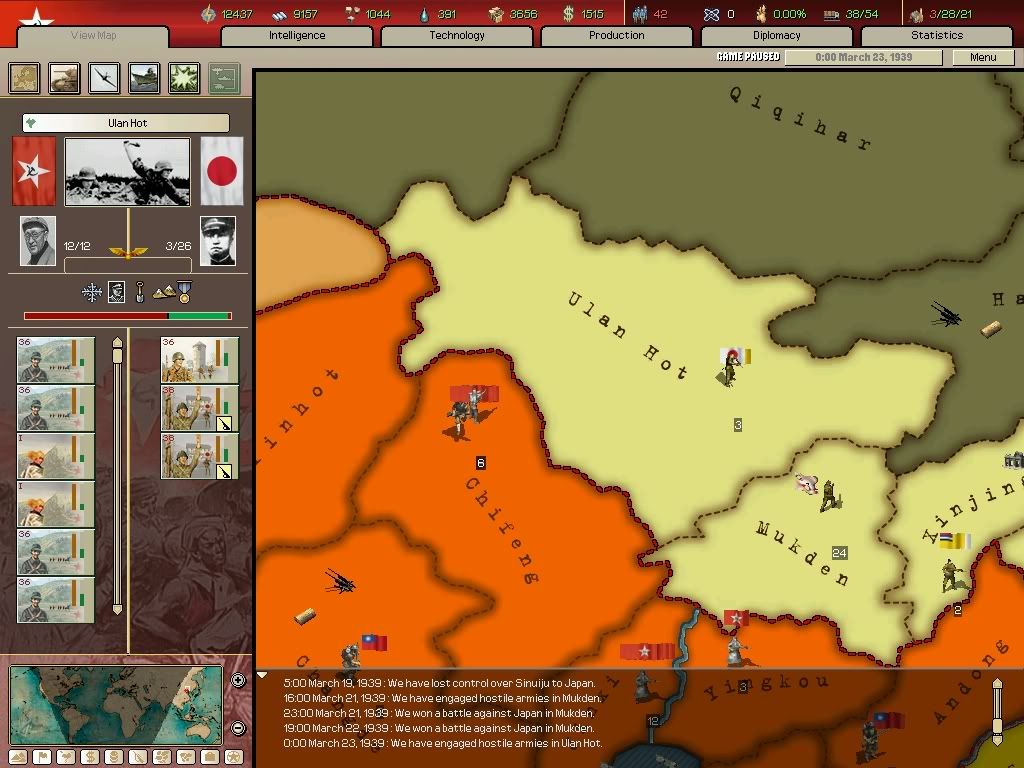
11 days later, on April 24, General Armament Department developed new methods of Modern Agriculture, and then immediately began updating the equipment of the infantry of the Red Army.
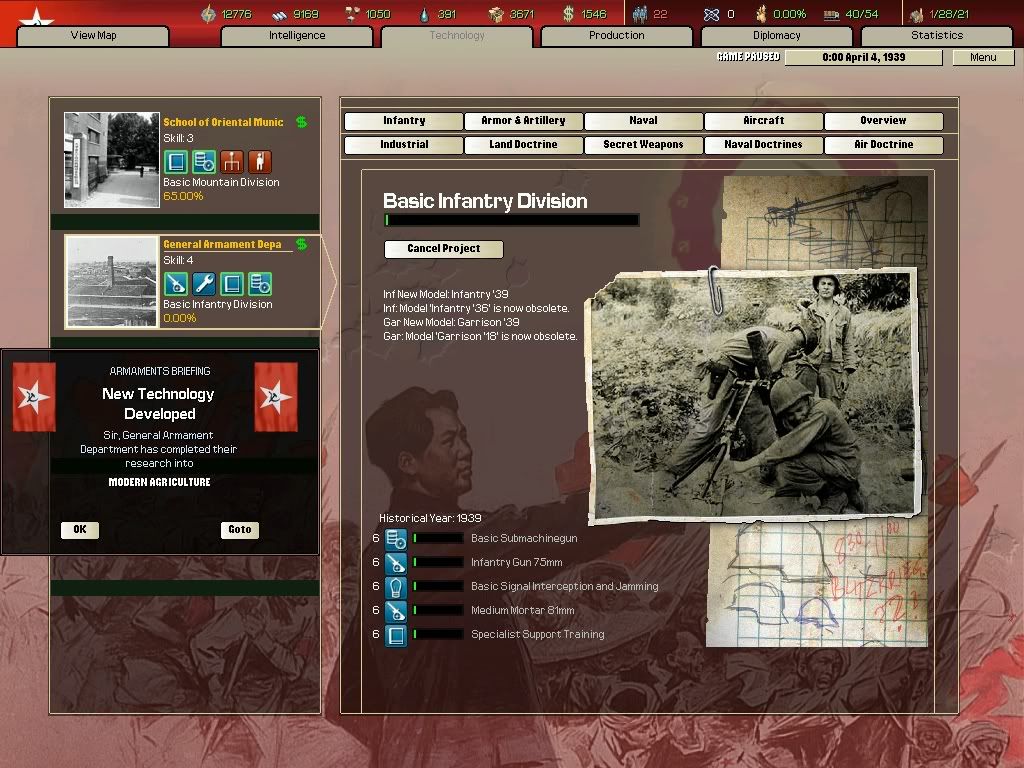
The Battle of Mukden finally ended on April 22, when Kuomintang forces managed to hold Mukden against the inevitable Japanese counterattack.
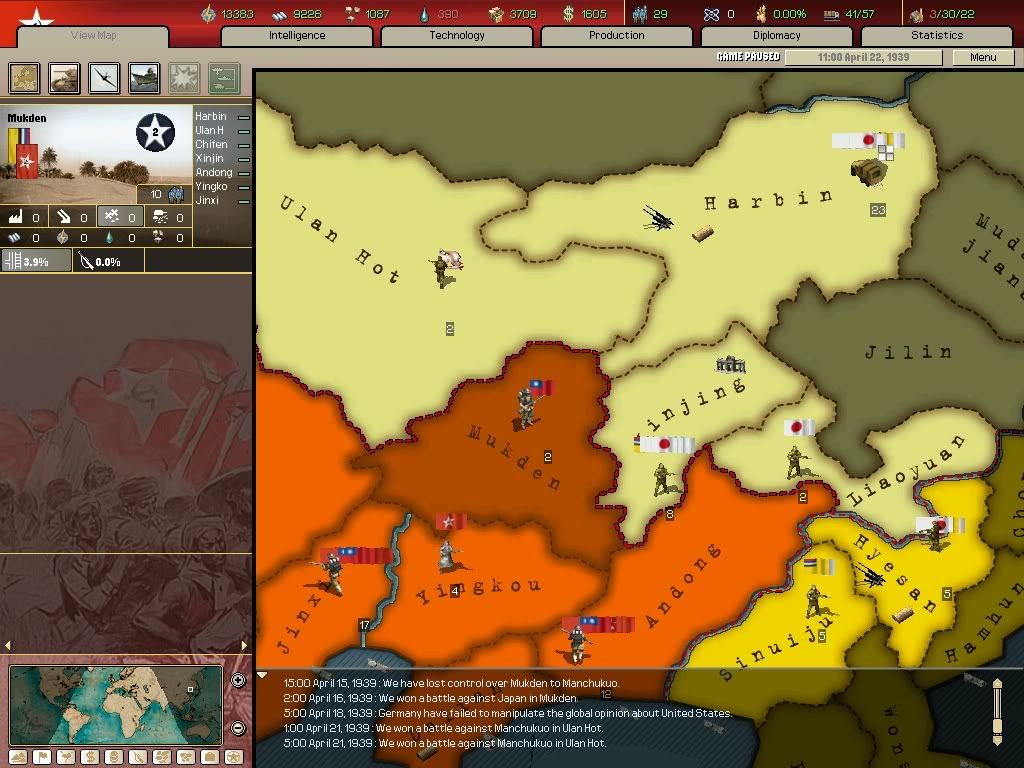
Red Army forces that were stationed in Jinxi, waiting for the Japanese to retake the province, were then dispached to Mukden.
Meanwhile, forces that had been marching for months to Ulan Hot were forced back by a Japanese counterattack.
In the South, Japanese forces once again expanded their territory.

On June 28, the School of Oriental Munich developed methods for a Basic Mountain Division, and Deng Xiaoping started development on a project that had been lost many moths earlier - a Basic Computing Machine.
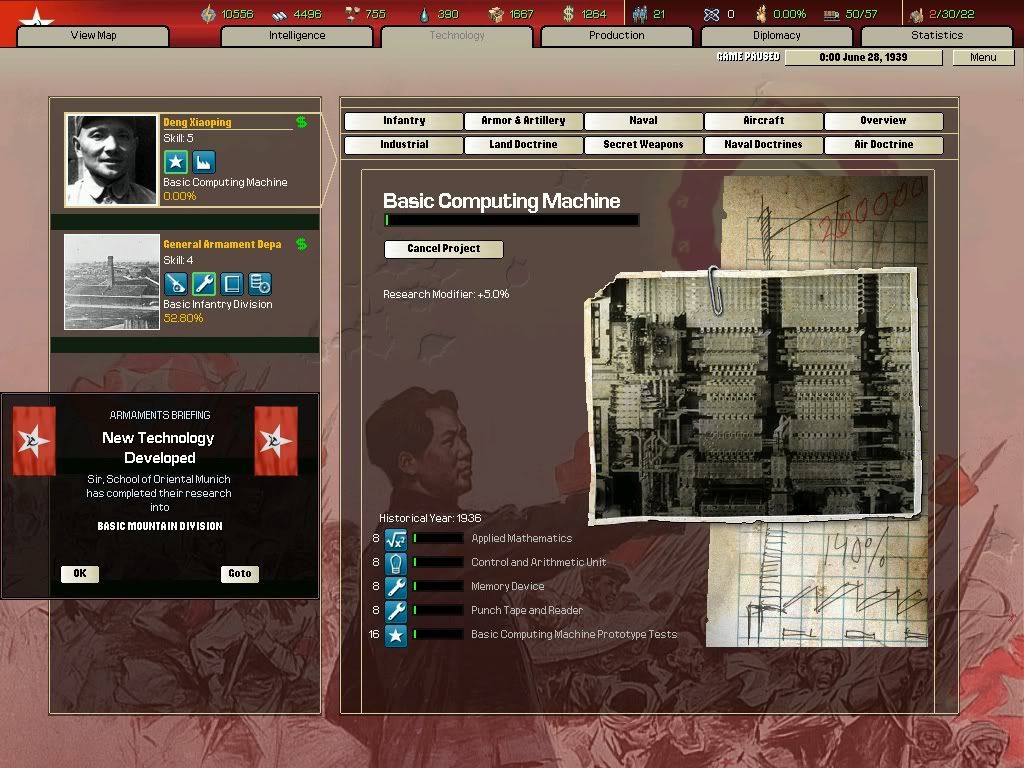
On March 23, 1939 an attack was made on Ulan Hot, the Japanese garrison of which had been greatly reduced by the never-ending battle of Mukden.

11 days later, on April 24, General Armament Department developed new methods of Modern Agriculture, and then immediately began updating the equipment of the infantry of the Red Army.

The Battle of Mukden finally ended on April 22, when Kuomintang forces managed to hold Mukden against the inevitable Japanese counterattack.

Red Army forces that were stationed in Jinxi, waiting for the Japanese to retake the province, were then dispached to Mukden.
Meanwhile, forces that had been marching for months to Ulan Hot were forced back by a Japanese counterattack.
In the South, Japanese forces once again expanded their territory.

On June 28, the School of Oriental Munich developed methods for a Basic Mountain Division, and Deng Xiaoping started development on a project that had been lost many moths earlier - a Basic Computing Machine.

It seems like the KMT and warlords are doing most of the fighting, gaining expirience etc. When you eventually decide to take out Nationalist China, try to inherit as much of the Nationalist Army as possible upon annexation. (Unless they manage to escapre to Tapei of course, but I'm sure you'll prevent that by landing there first).
Go China!


Go China!


Last edited:
Its always interesting to see how people play ComChi. And Im very impressed by what you have achieved so far.
Does CHC even have any naval tech teams?
If not, did you use the full techteam takeover?
If not, did you use the full techteam takeover?
Great work! The People's Liberation Army seems to be liberating people at a good pace. And as far as I know, CHC has naval techteams.
I am using the sprites from my HoI2 Sprites Compendium (in my signature). But if you want to download it I'd suggest that you wait for a couple (1-2) hours because I need to update it with BeBro's new ships. (it would be faster, but I literally just woke up)Admiral Yamamot said:Which sprites are you using?
I love them!
It doesn't matter if the Nationalists escape to Taiwan or not... I won't inherit their army because (IIRC) Nationalist China doesn't have its regular_id as CHC, I think.kami888 said:It seems like the KMT and warlords are doing most of the fighting, gaining expirience etc. When you eventually decide to take out Nationalist China, try to inherit as much of the Nationalist Army as possible upon annexation. (Unless they manage to escapre to Tapei of course, but I'm sure you'll prevent that by landing there first).
You will, in fact, soon see a fleet. But it won't be very big (yet), because I'm not allowing myself to build a fleet until I unite China.Hannibal Barca2 said:So... will we soon see a fleet?
They do, but they don't become avaliable until I get the event "Proclaiming the PRC", which doesn't happen until I unite China (except Tibet), which is why I'm not building a fleet until then, because I won't have the technology.trekaddict said:Does CHC even have any naval tech teams?
Rodrico Stak said:They do, but they don't become avaliable until I get the event "Proclaiming the PRC", which doesn't happen until I unite China (except Tibet), which is why I'm not building a fleet until then, because I won't have the technology.
I see.
Thats it. Im abandoning my germany game to do a CHC game with CCIP.
China Rules the Seas
A Chinese Naval AAR

Operation Fading Sun: Part 6
A Chinese Naval AAR

Operation Fading Sun: Part 6
On July 25, 1939, the Japanese made advances in encryption technology so that not even Head of Intelligence Li Kennong, who was particularly skilled in detecting armies (army detection +30%), could not determine exactly how many Japanese divisions were located in any given province. The Japanese high command, however, did not equip their Manchukuoan allies with new encryption devices, and Manchukuoan divisions consistently gave away the compositions of Japanese forces in the same province to the skilled intelligence team of Li Kennong.

On September 8, General Armament department developed ways to train a Basic Infantry Division. The newly formed (earlier in 1939) North China Industries Group was then contracted to develop better methods of construction.
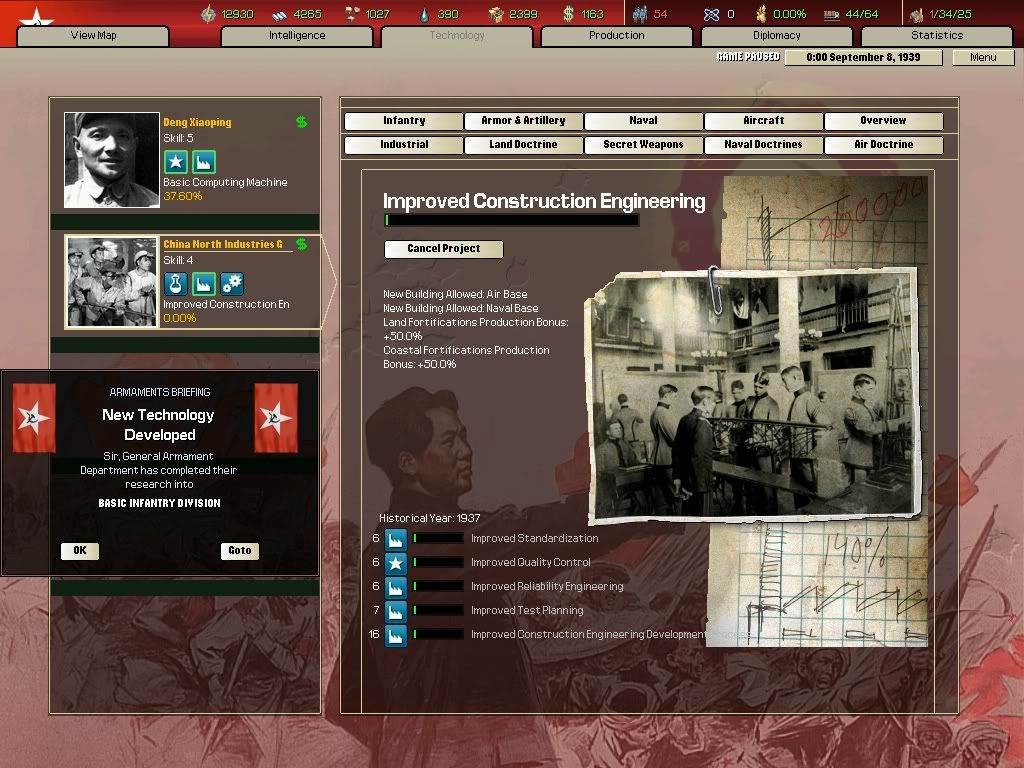
On the Southern Front, the Japanese were pushed into the province of Yantai.
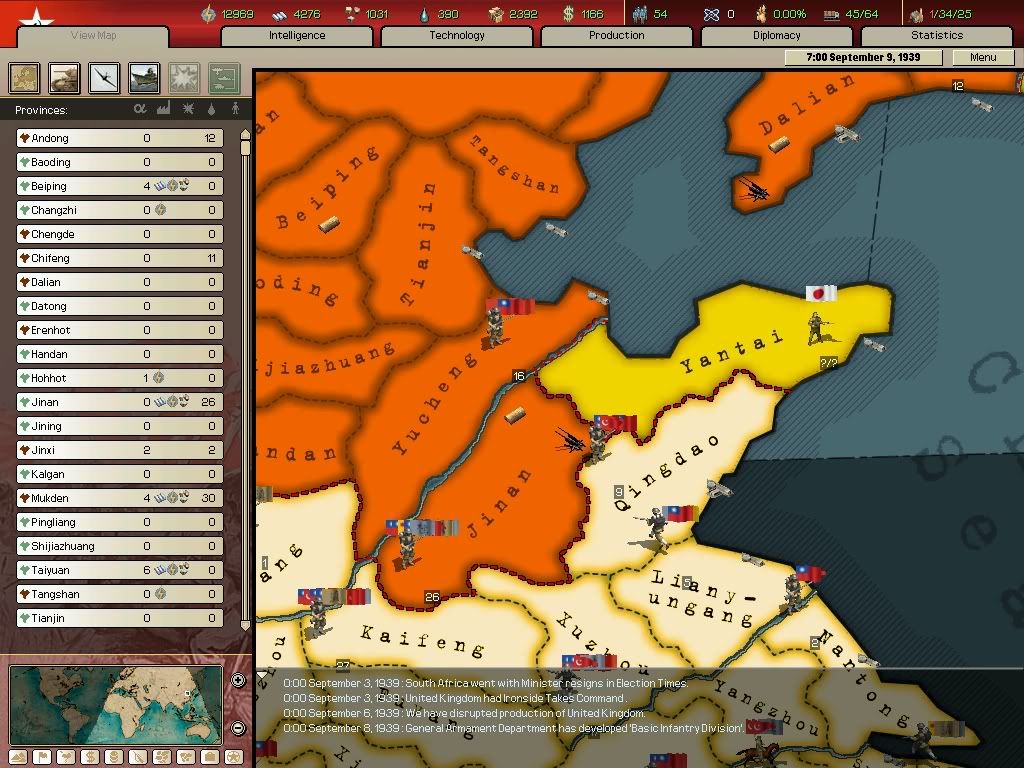
By September 15, all the Japanese divisions on the Southern Front had been forced to surrender. It had been a hard battle, but it had been won.
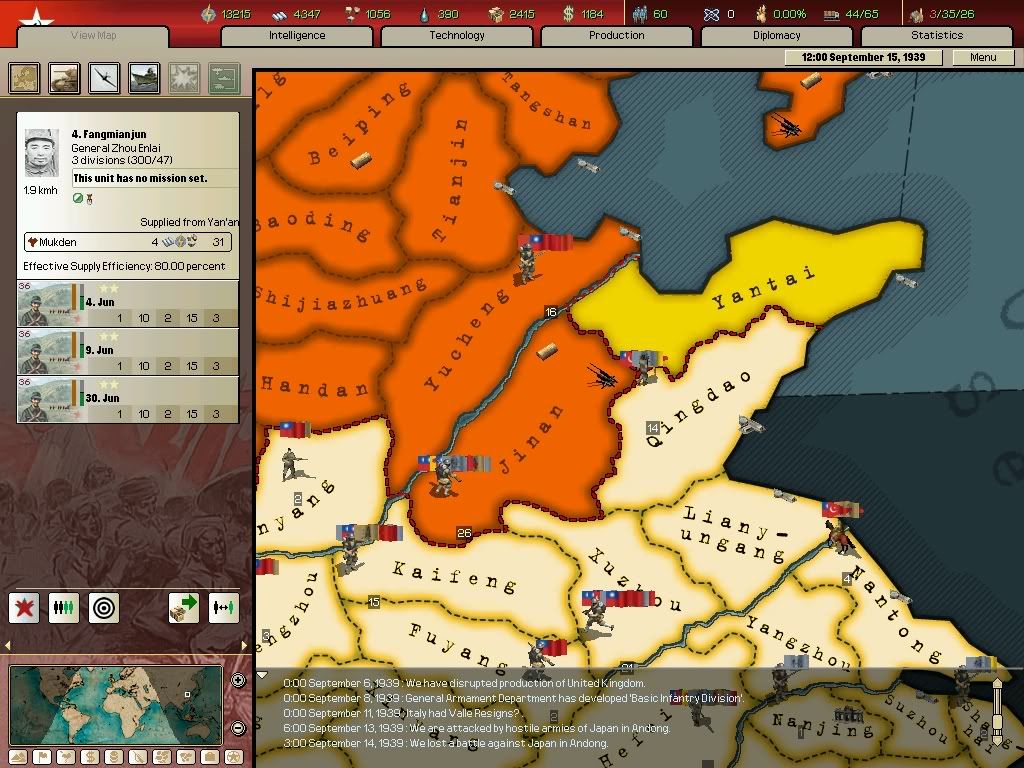
Meanwhile, on the Northern Front, the Japanese drove the Red Army out of Andong. This defeat would not go unavenged!
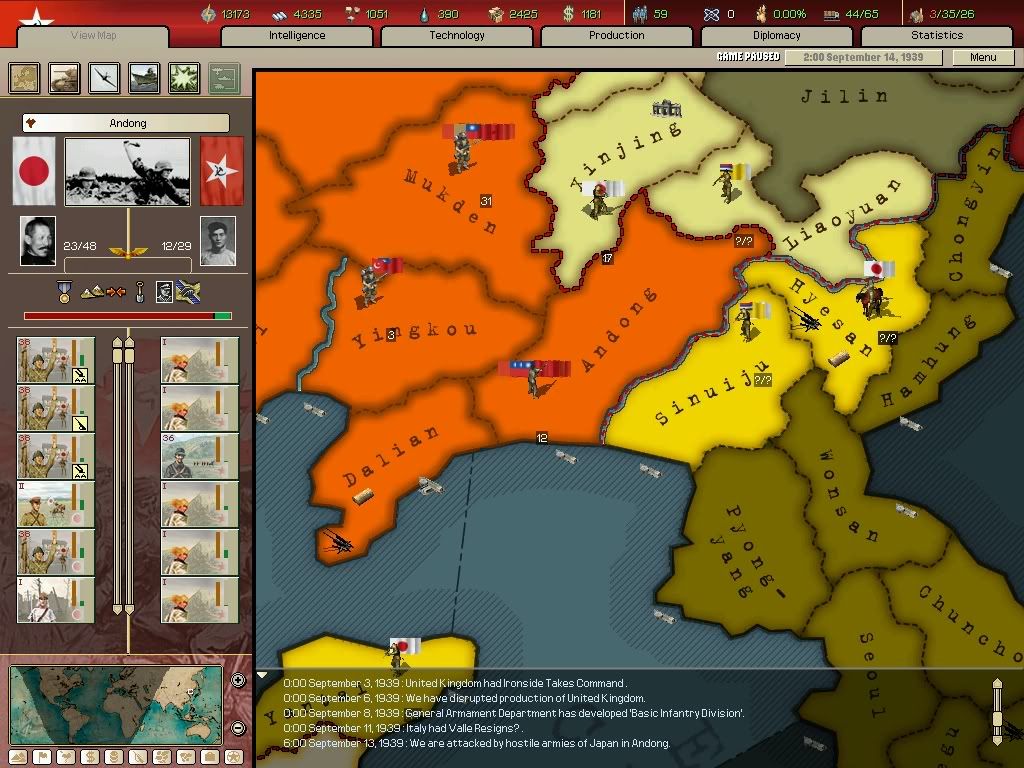
Attacks were made on Harbin, to distract the Japanese from our inevitable counterattack on Andong. Though one was made, it was not enough to keep the Japanese from retaking Dalian. During this time, the Nationalists made several attacks on the Manchukuoan capital of Mukden. Each was repelled by the Japanese counterattack.
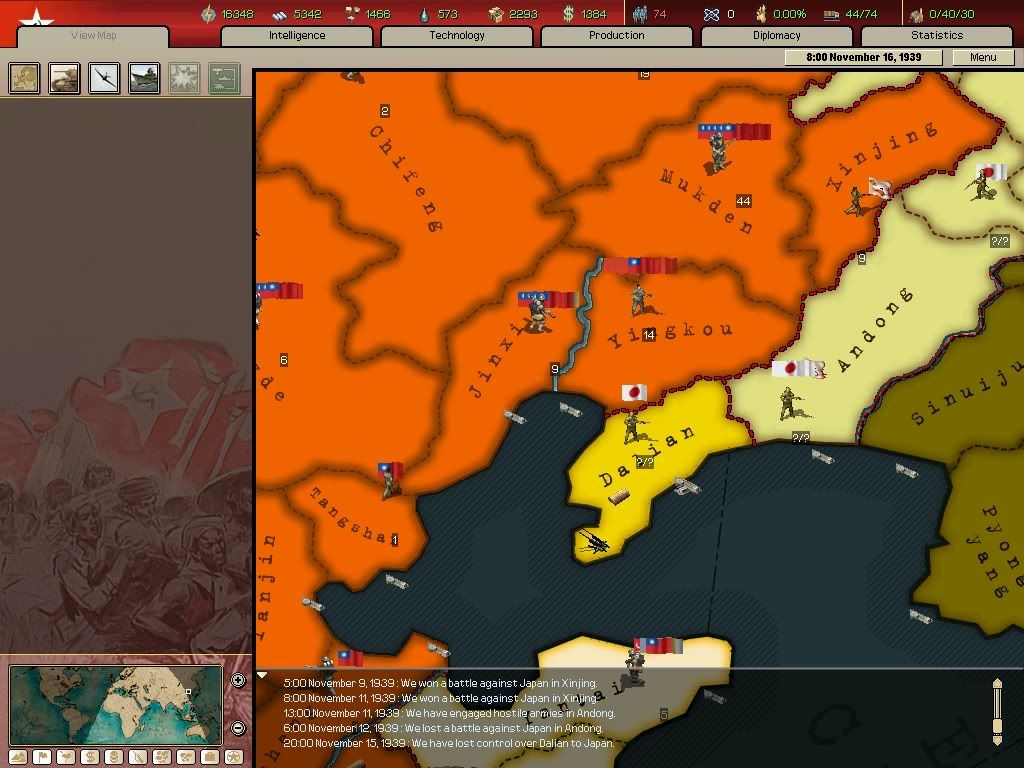
20 days before Japan took Dalian, the Red Army high command issued directive no. 103 - creation of the Red Airforce. Outdated Polikarpov I-15 biplanes would be imported from the Soviet Union, and though insufficient industry could be committed to the project, it was hoped that the wing would be completed by February 1940, to be used for reconnaissance over Japanese territory, hopefully providing the information that the intelligence service could no longer provide.
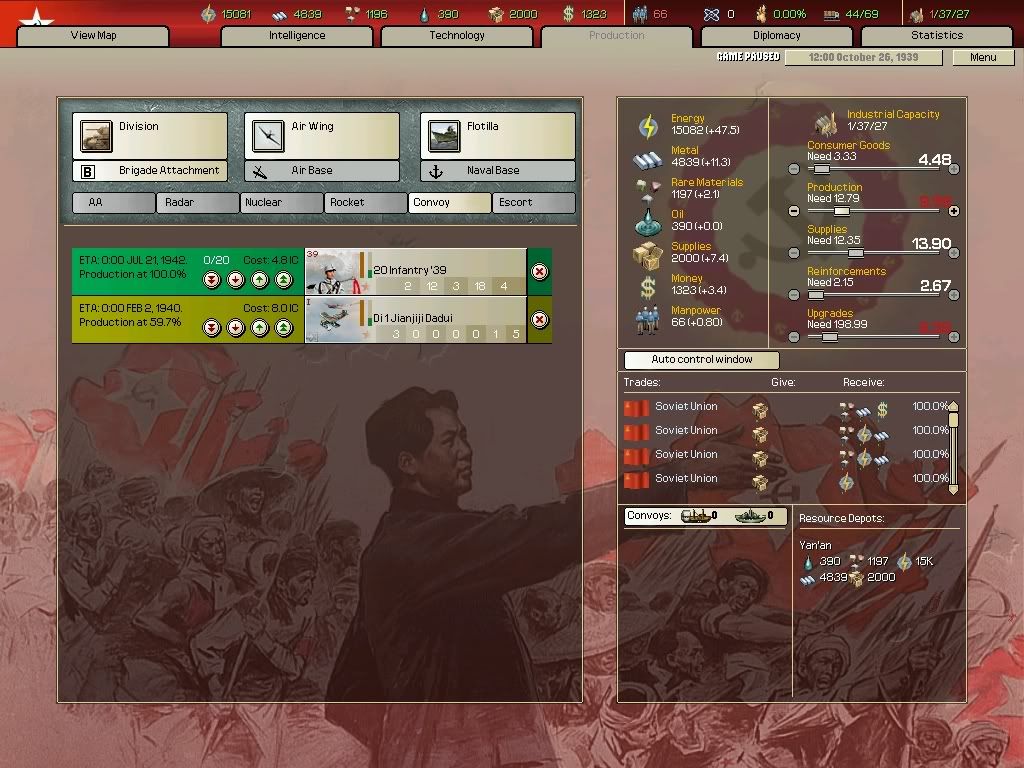
The counterattack to Dalian was very successful, as Lt. General Ma Benzhai's forces , supported by those of Field Marshal Zhou Enlai, achieved victory over the one Japanese division in Dalian.
